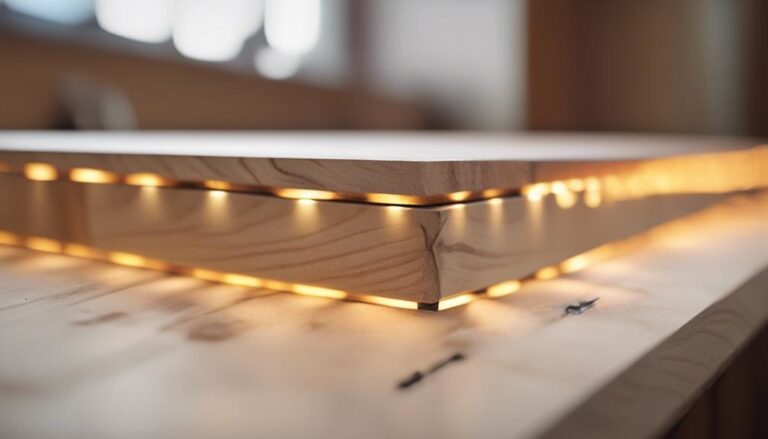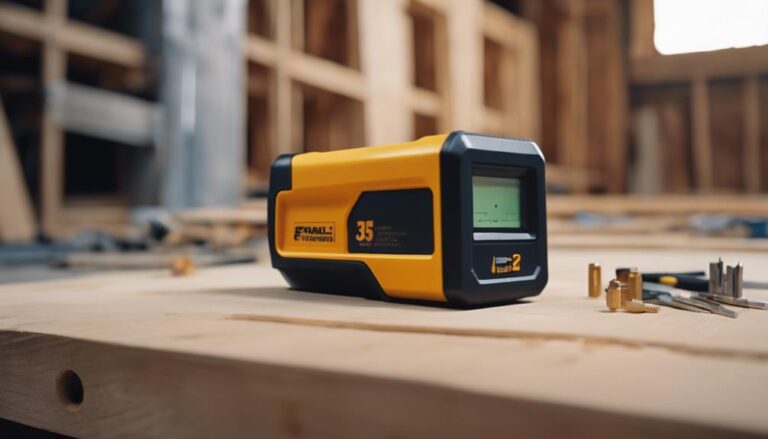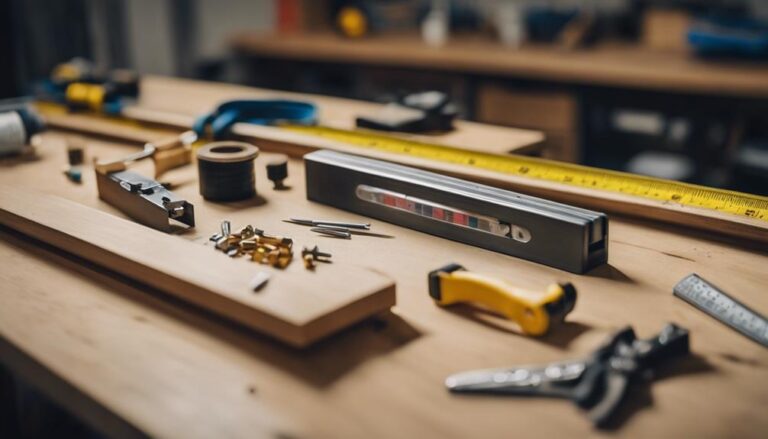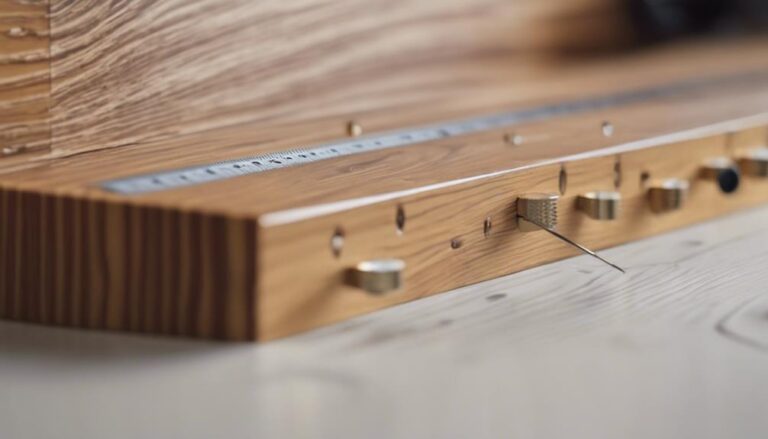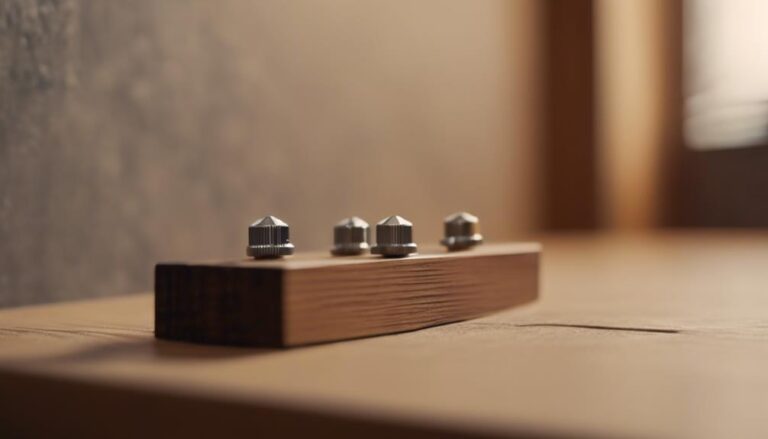Achieving Stability: Stud Finding for Successful Floating Wood Shelf Installation
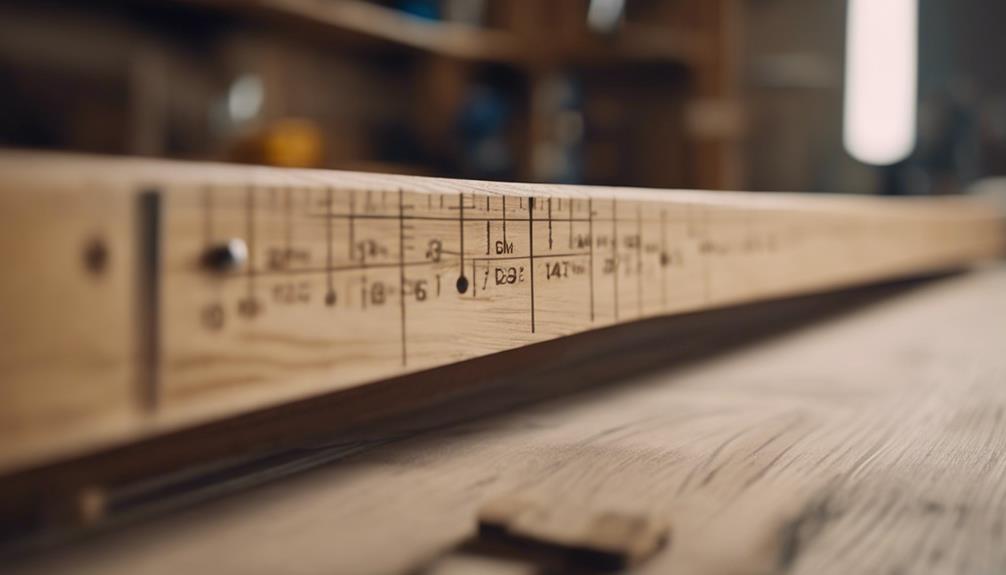
For stable floating wood shelves, it's crucial to use a stud finder to locate the robust wall studs accurately. These vertical supports are essential for distributing weight evenly and preventing any wobbling or potential collapse over time. By aligning the shelf brackets directly over these studs, you ensure a secure and long-lasting installation.
When wall studs aren't conveniently positioned, wall anchors become essential for added support. Choosing the right anchors for the specific wall material is key to maintaining a secure hold and preventing any potential loosening or instability of the shelves. This extra step is crucial in ensuring that your floating shelves remain secure and reliable over time.
Proper stud finding and anchoring techniques are fundamental for a successful floating shelf installation. By following these steps and paying attention to these details, you can enjoy a stable and durable shelving solution in your space.
Key Takeaways
- Employ a dependable stud finder to precisely locate robust vertical wall studs spaced either 16 or 24 inches apart for secure bracket positioning.
- Ensure the floating shelf brackets are aligned directly above the identified wall studs to guarantee uniform weight distribution and long-lasting stability.
- If wall studs are not conveniently positioned for the shelf installation, explore alternative wall anchoring solutions like specialized wall anchors.
- Select suitable wall anchoring hardware based on the weight capacity requirements and the composition of the wall material.
- The utilization of robust wall anchors and proper anchoring techniques is critical for establishing a robust and dependable floating wood shelf installation.
Determining the Ideal Shelf Placement
To start, we consider the optimal height and spacing for the floating wood shelf, taking into account both the room's style and practical requirements. It's essential to factor in the load-bearing capacity of the wall and the material of the shelf to ensure a secure installation. Using a stud finder becomes crucial in locating the wall studs, as positioning the shelf brackets directly onto the studs enhances stability and prevents any potential sagging in the future.
Accurate shelf placement is fundamental in creating a robust platform for displaying items while prioritizing safety. Precise measurements and markings are made to determine the ideal shelf location, guaranteeing that the brackets are firmly anchored into the wall studs.
This meticulous step is crucial as it enables the construction of a floating wood shelf that can support the weight of your displayed items, all while harmonizing with the overall design of the room.
Locating Wall Studs Using a Stud Finder
To accurately pinpoint the location of wall studs for our floating wood shelf installation, we'll rely on a stud finder. This handy device is specifically designed to detect the presence of these crucial structural elements hidden behind drywall.
By utilizing the stud finder's advanced sensors, we can precisely identify the sturdy vertical beams known as wall studs that are typically spaced 16 or 24 inches apart.
Wall studs serve as the essential anchoring points necessary for securely mounting our shelves. Detecting these studs with the stud finder is vital to ensure a stable foundation and to prevent any potential hazards or sagging due to inadequate support.
With the stud finder as our trusty guide, we can efficiently plan the layout of our floating shelves. This innovative tool will lead us to the exact spots where the studs are located, facilitating a successful and long-lasting installation.
Securely Mounting the Floating Shelf Brackets
Now that we've located the wall studs, it's time to confidently mount the floating shelf brackets. Proper bracket placement is crucial for ensuring the stability and weight-bearing capacity of your floating shelves.
| Bracket Placement Checklist | ||
|---|---|---|
| Locate Studs | ✓ | |
| Measure Bracket Placement | ✓ | |
| Level Bracket | ✓ | |
| Secure Bracket to Stud | ✓ | |
| Repeat for All Brackets | ✓ |
Mounting the brackets directly onto the wall studs provides the essential support to anchor the floating shelves securely. This prevents any risk of shelves falling or sagging, especially when supporting heavier loads. By using a stud finder and following best practices for correct bracket installation, we can ensure your floating shelves are firmly secured to the wall. Attention to detail is key to achieving the clean, minimalist look you desire while maintaining the necessary weight capacity for your storage needs.
Customizing the Shelf Length to Fit
To ensure a precise fit, it's essential to measure the wall space and the shelf accurately. This allows us to customize the shelf length to optimize storage capacity and maintain a seamless, visually appealing appearance.
Precise Measurements Needed
Crafting the perfect floating wood shelf length relies on precise measurements, ensuring a seamless fit in your chosen space. We understand the importance of achieving a tailored look that aligns with your specific design preferences and room dimensions. Accurate measurements are key to determining the ideal length for your floating wood shelf, enhancing both its stability and visual appeal.
For a secure and stable installation, it's essential to follow these three key steps:
- Utilize a reliable stud finder to pinpoint the optimal placement for your shelf brackets, establishing a strong foundation.
- Carefully measure the length of your wall space, taking into account any obstacles or existing decor that may affect the placement.
- Customize the shelf length accordingly to create a cohesive and seamless appearance that complements your unique space.
Precise measurements serve as the cornerstone for a successful floating wood shelf installation. By investing the time in getting it right, you can enjoy a beautiful, sturdy, and enduring addition to your home.
Trimming Shelf to Size
Now that we've emphasized the importance of precise measurements for your floating wood shelf, let's dive into customizing the shelf length to perfectly fit your space.
Trimming the shelf to size is a crucial step in the installation process, ensuring a seamless and professional appearance.
To begin, carefully use a saw to trim the shelf to the exact length required for your installation space. It's essential to measure accurately and double-check the fit to guarantee a precise result. This level of attention to detail will result in a snug and secure installation that enhances the overall look of your floating wood shelf.
After trimming, take some sandpaper to smooth and clean the edges, creating a polished and refined finish.
Arranging Decorative Elements on the Shelves
When setting up our floating wood shelves, it's essential to carefully arrange the decorative items to enhance the overall look and create a visually captivating display. Considering the weight and dimensions of each piece is crucial to ensure a well-balanced arrangement across the shelves.
Mixing various heights and sizes of items will add depth and make the display more visually engaging, whether it's plants, artwork, books, or personal keepsakes, each contributing to the space's unique style.
To simplify the process of arranging items, it's helpful to use trays or containers to group smaller decorative elements together, creating a cohesive appearance. Trying out different placements and making adjustments as necessary will help achieve the desired aesthetic. It's important to focus on achieving a sense of balance and harmony in the overall display.
When installing floating wood shelves, finding the studs in the wall is paramount to ensure they can support the weight of the shelves and the decorative items placed on them. Using a stud finder tool can help locate the studs accurately, providing a secure foundation for the shelves. This step is crucial in preventing any accidents or damage due to improper installation.
In conclusion, thoughtful consideration and strategic placement of decorative items on floating wood shelves can elevate the visual appeal of the space. By incorporating a mix of items in varying sizes, using trays for grouping, and paying attention to balance, we can create a stylish and harmonious display.
Additionally, ensuring proper installation by locating and anchoring the shelves to studs will guarantee both aesthetic charm and structural stability.
Maintaining the Stability of Floating Shelves
When installing floating wood shelves, it's crucial to carefully consider how the weight is distributed and ensure proper wall anchoring. Locating solid wall supports using a stud finder is essential for securely mounting the shelves and preventing any potential sagging or accidents in the future.
Following these stud finding guidelines is key to guaranteeing the long-term stability and safety of your floating wood shelves.
Securing Load Distribution
Properly distributing the weight across strategically positioned studs is crucial for ensuring the stability and durability of our floating wood shelves. Using a stud finder is essential to accurately locate the wooden support beams within the wall, as they provide the necessary weight capacity to securely anchor our installations.
By ensuring that the floating shelf brackets are precisely aligned with the studs, we can ensure that the shelves remain level and securely in place over time.
For best results, we suggest:
- Conducting a thorough scan of the wall using a reliable stud finder to pinpoint the exact positions of the wooden studs.
- Aligning the shelf brackets directly over the studs to evenly distribute the weight and prevent any potential sagging or instability.
- Using robust wall anchors specifically designed for heavy-duty applications to firmly fasten the brackets into the studs for a successful floating shelf installation.
Accurately locating the studs is the fundamental aspect of creating floating wood shelves that not only look stylish but also offer exceptional stability.
Wall Anchoring Considerations
When it comes to installing floating wood shelves, finding studs is crucial for ensuring stability and security. However, in cases where studs aren't conveniently located, we need to explore alternative wall anchoring solutions to support the shelves effectively.
The durability and longevity of our shelves depend on the strength and reliability of the anchoring method we choose. In situations where traditional stud placement isn't an option, utilizing wall anchors designed for specific wall materials such as drywall, plaster, brick, or concrete is essential.
These specialized anchors are engineered to provide a secure grip and prevent the shelves from wobbling or collapsing. Selecting the right anchoring hardware depends on the weight capacity requirements of the floating shelves and the composition of the wall itself.
By carefully considering the type of wall anchors needed and ensuring they're installed correctly, we can maintain the integrity and safety of our floating wood shelves even without direct access to studs.
Prioritizing proper anchoring techniques will help us achieve a sturdy and reliable installation that lasts over time.
Frequently Asked Questions
Do You Need to Find Studs for Floating Shelves?
Studs are crucial for supporting floating shelves properly. By locating and anchoring the shelves to studs in the wall, you ensure stability and durability for your shelving unit. Without this essential step, the shelves may sag or even fall over time, risking damage to your walls and belongings.
When it comes to installing floating shelves, finding studs is a non-negotiable task. Studs provide the necessary support to hold the weight of the shelves and their contents without compromising the integrity of the wall. Using a stud finder or tapping method can help you locate these vertical framing members behind the drywall, giving you a solid foundation for your shelves.
In addition to stud placement, you have the freedom to explore various design options for your floating shelves. Consider factors such as shelf positioning, color coordination, style preferences, and customization possibilities to create a visually appealing and highly functional storage solution that suits your space and personal taste. With the right combination of stud finding and design choices, you can achieve a well-balanced and attractive shelving arrangement in your home.
How to Stabilize Floating Shelves?
Understanding the importance of shelf stability is crucial when it comes to installing floating wood shelves in your home. By incorporating sturdy materials, such as solid wood or engineered wood, and utilizing custom-made brackets for added support, you can ensure that your floating shelves are not only visually appealing but also incredibly secure.
One key element to consider when installing floating shelves is the use of a stud finder. Studs are vertical wooden or metal supports within your walls that provide the necessary strength to support heavy items. By locating and anchoring your brackets into studs, you can significantly increase the stability of your floating shelves.
When it comes to wall anchoring, it's essential to use high-quality wall anchors that are suitable for the weight capacity of your shelves. These anchors help distribute the weight evenly across the wall, preventing any potential sagging or instability over time.
How Do You Install Sturdy Floating Shelves?
When installing sturdy floating shelves, it's crucial to consider the optimal shelf depth based on the intended use and the items to be placed on them. By carefully selecting the right depth, you can ensure stability and functionality for your shelves.
Spacing between the floating shelves is another essential factor to take into account. Proper spacing not only enhances the overall aesthetic appeal of the shelves but also contributes to their structural integrity. It's advisable to follow standard guidelines or get creative with unique spacing options to achieve the desired look.
When comparing materials for floating shelves, wood is often a popular choice due to its durability and visual appeal. However, it's essential to consider the weight capacity of the shelves and choose materials that can support the items you plan to display. Additionally, incorporating metal brackets or supports can further enhance the sturdiness of the shelves.
To enhance the aesthetics of your floating shelves, you can customize options such as finishes, colors, and shapes to complement your existing decor. By personalizing the design, you can create a cohesive and visually appealing shelving solution that adds character to your space.
Implementing smart installation techniques, such as using a stud finder to locate wall studs for secure anchoring, is crucial for ensuring the stability of floating shelves. By following proper installation procedures and using the right tools, you can prevent accidents and enjoy long-lasting, functional shelving.
Lastly, implementing maintenance strategies, such as regularly checking for any signs of wear or damage, can help prolong the lifespan of your floating shelves. By addressing any issues promptly and maintaining the shelves properly, you can ensure they remain sturdy and visually appealing for years to come.
How Do I Make Sure My Floating Shelves Are Secure?
To ensure our floating shelves are securely mounted, we need to consider a few key factors. First, it's crucial to evenly distribute the weight on the shelves to prevent any potential strain on the mounting hardware. This can be achieved by placing heavier items towards the center and lighter items towards the ends of the shelves.
When it comes to mounting hardware, opting for sturdy and reliable anchors or brackets is essential for ensuring the shelves stay in place. Make sure to choose hardware that is appropriate for the weight and size of the shelves to provide maximum support.
Proper alignment of the shelves is also vital for both stability and aesthetics. Using a level and measuring tape to ensure the shelves are precisely aligned will not only create a visually pleasing display but also help distribute the weight evenly.
Lastly, get creative with how you accessorize and style your floating shelves. By adding decorative items, plants, or books, you not only maximize their space-saving potential but also add a personal touch to your home decor.
Conclusion
We've delved into the essential steps for ensuring stability during the installation of a floating wood shelf. By accurately pinpointing the wall studs, firmly securing the brackets, and tailoring the shelf length to fit your space, we can craft a robust and aesthetically pleasing showcase that will endure the test of time.
Similar to a masterfully constructed vessel navigating turbulent waters, your floating shelf will stand steadfast, bringing you joy for years to come.

